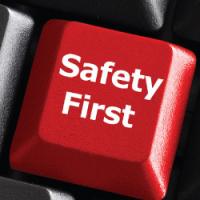- Posts: 350
- Thank you received: 11
Slips and Falls
- Safety Toolbox Talk Webmaster
-
 Topic Author
Topic Author - Offline
- Administrator
-

An unguarded wet floor is one of the many causes that accounted for over 10 million injuries last year at work. In Michigan, 17.4 percent of all Workers' Compensation cases were due to injuries sustained from falling or slipping on the job. It is important to spot unsafe conditions which may lead to slips and falls and prevent them.
There are various ways to suffer slips and falls while working. You can slip and lose your balance, you can trip over objects left improperly in your walkway, or you can simply fall from an elevated position above the ground.
To avoid slips and falls, be on the lookout for foreign substances on the floors. Watch for deposits of water, food, grease, oil, sawdust, soap, or debris. Even small quantities are enough to make you fall.
When entering a building from the outdoors or from debris areas, clean your footwear thoroughly. Snowy and rainy weather requires a door mat at each entrance to allow for complete wiping of shoes. Don't go too fast, walk safely and avoid changing directions too sharply.
Beware of tripping hazards. Any object left in the aisles or other areas designed for pedestrian traffic invites falls. Extension cords, tools, carts, and other items should be removed or properly barricaded. If equipment or supplies are left in walkways, report it. Let the proper personnel remove it. Keep passageways clean of debris by using trash barrels. If you project trash into a can but missed, PICK IT UP!
Walk where you're supposed to walk. Short cuts through machine areas invite accidents. Concentrate on where you are goinghorseplay and inattention leaves you vulnerable to unsafe conditions.
Hold on to handrails when using stairs or ramps. They are there to protect you should a fall occur. If you're carrying a heavy load which hampers your ability to properly ascend or descend stairs, use the elevator, or find help!
The worst falls are from elevated positions like ladders and scaffolding. They may result in serious injuries and death.
Learn and practice ladder safety and the proper use of scaffolding.
When climbing, use a ladder of proper length that is in good condition. Keep it placed on a firm surface. Do not climb a !adder placed on machinery, crates, stock or boxes. Keep the ladder's base one foot away from the wall for every four feet of height. Don't over-reach. Always have control of your balance when working from a ladder. Never climb a ladder with your hands full, and always carry tools in proper carrying devices.
When using a scaffold, be sure it is properly assembled according to the manufacturer's specifications. Check carefully for defects. Standing and working planks should be level and clean. Use toe boards to prevent tools from falling and workers from slipping. Work only with people who practice scaffold safety.
Slips and falls occur every day. The extent of injuries and their recurrence can be minimized through proper safety knowledge and attitudes. Practice safety . . . don't learn it through "Accidental Experience."
Please Log in or Create an account to join the conversation.
